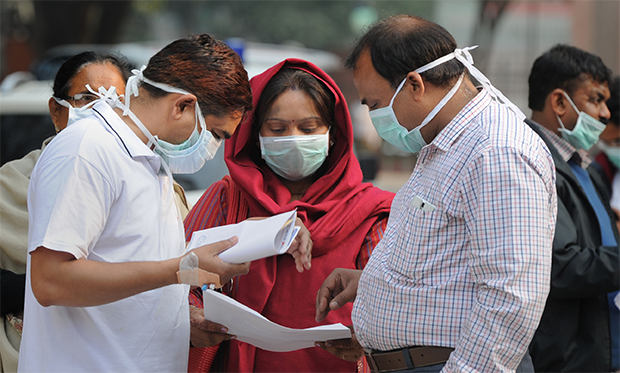|
Swine flu, also known as the H1N1 virus, is a
relatively new strain of an influenza virus that causes symptoms similar
to the regular flu. Swine flu is spread primarily from person to person.
Swine flu made headlines in 2009 when it was first discovered in humans
and became a pandemic. Pandemics are contagious diseases affecting
people throughout the world or on multiple continents at the same time.
The World Health Organization (WHO) declared the H1N1 pandemic over in
August of 2010. Since then, the H1N1 virus has been known as a regular
human flu virus. It continues to spread during flu season like other
strains of the flu. The flu shot developed each year by the Centers for
Disease Control and Prevention (CDC) usually includes a vaccination
against a type of H1N1 virus.
Like other strains of the flu, H1N1 is highly contagious, allowing it to
spread quickly from person to person. A simple sneeze can cause
thousands of germs to spread through the air. The virus can linger on
tables and surface areas like door knobs, waiting to be picked up.
The best means of dealing with swine flu is to prevent it. Hand
sanitization is important to stop the spread of the virus, and staying
away from infected people will help stop person-to-person transmission.
|
|
 |
|
Risk Factors for Swine Flu
When it first emerged, swine flu was most common in young adults. This
was unusual because most flu viruses attack older adults or the very
young. Today, risk factors for getting swine flu are the same as for any
other strain of the flu. You’re most at risk if you spend time in an
area with a large number of people who are infected with swine flu.
Some people are at higher risk for becoming seriously ill if they’re
infected with swine flu. These groups include:
adults over age 65
children under 5 years old
young adults under age 19 who are receiving long-term aspirin therapy
people with compromised immune systems (due to a disease such as AIDS)
pregnant women
people with chronic illnesses such as asthma, heart disease, diabetes or
neuromuscular disease
Causes of Swine Flu
Swine flu is caused by a strain of influenza virus that usually only
infects pigs. Unlike typhus, which can be transmitted by lice or ticks,
transmission usually occurs from person to person, not animal to person.
You can’t catch swine flu from eating pork products.
Swine flu is very contagious. The disease is spread through saliva and
mucus particles. People may spread it by:
sneezing
coughing
touching a germ-covered surface and then touching their eyes or nose
Symptoms of Swine Flu
The symptoms of swine flu are very much like those
of regular influenza. They include:
chills
fever
coughing
sore throat
runny or stuffy nose
body aches
fatigue
diarrhea
nausea and vomiting
|
|

|
|
Diagnosing Swine Flu
Your doctor can make a diagnosis by sampling fluid from your body. To
take a sample, your doctor or a nurse may swab your nose or throat.
The swab will be analyzed using various genetic and laboratory
techniques to identify the specific type of virus.
Treating Swine Flu
Most cases of swine flu don’t require medication for treatment. You
don’t need to see a doctor unless you’re at risk for developing medical
complications from the flu. You should focus on relieving your symptoms
and preventing the spread of the H1N1 to other people.
Two antiviral drugs are recommended for treating swine flu: the oral
drugs oseltamivir (Tamiflu) and zanamivir (Relenza). Because flu viruses
can develop resistance to these drugs, they’re often reserved for people
who are at high risk for complications from the flu. People who are
otherwise generally healthy and get swine flu will be able to fight the
infection on their own.
Swine Flu Symptom Relief
Methods for managing the symptoms of swine flu are
similar to the regular flu:
Get plenty of rest. This will help your immune system focus on fighting
the infection.
Drink plenty of water and other liquids to prevent dehydration. Soup and
clear juices will help replenish your body of lost nutrients.
Take over-the-counter pain relievers for symptoms such as headache and
sore throat.
|
|

|
|
Outlook for Swine Flu
Severe cases of swine flu can be fatal. Most fatal cases occur in those
with underlying conditions, such as HIV/AIDS. The majority of people
with swine flu recover and can anticipate a normal life expectancy.
Preventing Swine Flu
The best way to prevent swine flu is to get a
yearly flu vaccination. Other easy ways to prevent swine flu include:
frequently washing hands with soap or hand sanitizer
not touching your nose, mouth, or eyes (the virus can survive on
surfaces like telephones and tabletops)
staying home from work or school if you're ill
avoiding large gatherings when swine flu is in season
It’s important to follow any public health recommendations regarding
school closures or avoiding crowds during the flu season. These
recommendations may come from the CDC, WHO, National Institutes of
Health, or other governmental public health institutions.
Flu season shifts from year to year, but in the United States it
generally starts in October and runs until as late as May. It usually
peaks in January, although it’s possible to get the flu any time of
year. |